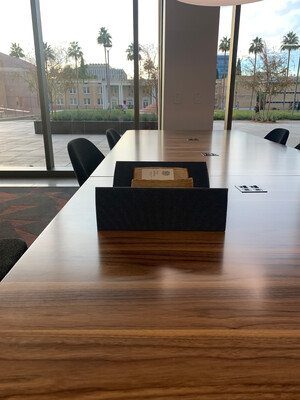
Hello, my name is Julie Tanaka, and I am the new Curator of Rare Books and Manuscripts for Distinctive Collections at ASU Library. I arrived in Tempe in the midst of the coronavirus pandemic so I have yet to see the collections in person, but I am looking forward to discovering what they hold. Prior to coming to ASU, I was Curator of Special Collections and Western European History Librarian for Hesburgh Libraries at the University of Notre Dame in Indiana. Grounding my work with rare and unique materials are an MLIS from the University of Washington, a Certificate in Special Collections from the University of Illinois, Urbana-Champaign, and a PhD in History with a specialty in pre-modern German history and literature from the University of California, Berkeley.
As I’ve been relegated to working virtually with the collections, I’ve had some time to think about how I can take many of the things that are important to me—teaching, outreach, collaboration, accessibility—and implement them at ASU. I have ideas and look forward to partnering with colleagues in the library, across campus, and in the community to make everything in Rare Books and Manuscripts discoverable and accessible.
In future posts, I will share objects from the collections, some reflecting my own particular curiosities to give a sense of my curatorial interests and training but most representing the breadth and inclusiveness of our collections. Old and new, print and digital, manuscript and book, maps and realia, historical and artistic, scientific and literary, big and small—the list goes on. It is my intent to capture imaginations, to inspire thought, to educate and to inform all while opening the doors to the fascinating world of rare books and manuscripts.
Here are a couple of items in the collections that I have done some work on in the past and of which I am fond:
Leonhart Fuchs, “De historia stirpium" (1542). Fuchs (1501-66) along with Otto Brunfels (1489-1534) and Hieronymus Bock (1498-1554) is regarded as one of the three German founders of Botany. The illustrations in "De historia stirpium" do not depict general characteristics of individual specimens but rather represent particular plant species in idealized form. ASU also holds Brunfels, "Herbarum vivae eicones" (1530-32) and Bock, "Kreutterbüch" (1572). All three works are part of the Doris and Marc Patten Collection of Herbals.
Julie Chen, "Chrysalis" (2014). Chen is an internationally renowned, California book artist. "Chrysalis" is a sculptural piece that requires the reader to interact with it to reveal its full content, something characteristic of Chen’s works. According to Chen, "Chrysalis" explores the complex and transformative process of grief. In addition to this piece, ASU holds her "Ode to a Grand Staircase (for Four Hands)" (2001), "View" (2006), "Panorama" (2008), and "How Books Work" (2010) in its collection of artist's books.
Here are a few pieces that caught my attention and that I am looking forward to learning more about soon:
Maestro Dardi, "Algeblle amugabala" (1429?). Maestro Dardi of Pisa (fl. early 14th c.) composed what is believed to be one of the earliest vernacular treatises on algebra. ASU holds an early 15th-century illustrated manuscript copy of Dardi’s 1344 treatise.
Jimmy Starr Papers. Jimmy Starr (1904-90) was an actor, author, and film columnist in Hollywood. This collection includes photographs, correspondence, scrap books, movie stills, newspaper clippings, and other materials.

William W. Sage Collection on Laos. Sage was an alumnus of and adjunct professor at ASU who spent over 40 years involved in international humanitarian aid. This collection contains a variety of formats—manuscripts, photographs, audiotapes, and ephemera—that cover topics including history, politics, culture, war, agriculture, economics, education, and more. Portions of this collection can be viewed on ASU Library's Digital Repository.